美国商标法.docx
商标法 英文版本

Article 5
Two or more natural persons, legal entities or other organizations may jointly file an application for the registration for the same trademark with the Trademark Office, and jointly enjoy and exercise the exclusive right to use the trademark.
第一条为了加强商标管理,保护商标专用权,促使生产、经营者保证商品和服务质量,维护商标信誉,以保障消费者和生产、经营者的利益,促进社会主义市场经济的发展,特制定本法。
Article 1
This Law is enacted for the purposes of improving the administration of trademarks, protecting the exclusive right to use trademarks, and of encouraging producers and operators to guarantee the quality of their goods and services and maintaining the reputation of their trademarks, with a view to protecting the interests of consumers, producers and operators and to promoting the development of the socialist market economy.
《十二国商标法》美国兰哈姆法

译者的话在美国,商标传统上是由普通法保护的,但早在1791年,托马斯.杰弗逊就曾建议利用美国宪法的贸易条款对帆布制造商的商标进行保护。
知道1870年,美国国会才首次建立了保护商标的联邦管理制度,但这个基于宪法版权条款的法令很快就被美国最高法院宣布为违宪。
1881年美国国会基于宪法的贸易条款制定了新的商标法,并于1905年进行了最主要的一次修订。
1946年,美国国会通过了《兰汉姆法案》,确立了对商标的联邦保护和注册,并据此建立了美国专利商标局。
该法案此后历经修改,实施至今。
笔者所译的《兰汉姆法案》为2004年12月23日修订后的版本。
相较以前的译本,本译本主要增加了马德里议定书的内容。
美国于2003年11月2日加入了马德里议定书。
为了适应马德里议定书的要求,美国对《兰汉姆法案》进行了相应的修改。
《兰汉姆法案》中规定的许多制度与我国的商标制度不同,如主辅注册簿制度,在先使用的原则,使用商标的声明,并存注册,淡化理论等。
笔者希望本译本能够对商标界的学者和从业人员进一步了解美国商标制度有所帮助,从而推动我国商标制度的发展。
此外,笔者还希望本译本中增加的有关马德里议定书的部分,能对我国企业通过马德里体系在美国注册商标有所帮助,从而促进我国企业在美国的商标权利保护和对美国市场的开拓。
在本译本的翻译过程中,笔者得到了国家工商总局资深商标专家吴群老师的悉心指导和大力帮助,在此表示衷心的感谢。
由于时间仓促,笔者水平有限,译稿难免存在不尽如人意之处,恳请各位读者批评指正。
一般条款1111.注册标注;在商标上展示;在侵权诉讼中追索权益和赔偿尽管有本法第1072条的规定,在专利商标局注册商标的注册人可在其商标上标注“已在美国专利与商标局注册”的文字或R加一个圈,即®,以显示其商标已获注册;注册人如未作如上标注,在其依本法提起的侵权诉讼中,将不能依据本法的规定获得权益或损害赔偿,除非被告已事实上知道了该注册。
1111.Notice of registration; display with mark; recovery of profits and damages in infringement suit.Notwithstanding the provisions of section 1072 of this title, a registrant of a mark registered in the Patent and Trademark Office, may give notice that his mark is registered by displaying with the mark the words ”Registered in U.S. Patent and Trademark Office” or “Reg. U.S. Pat. & Tm. Off.” or the letter R enclosed within a circle, thus ®; and in any suit for infringement under this chapter by such a registrant failing to give such notice of registration, no profits and no damages shall be recovered under the provisions of this chapter unless the defendant had actual notice of the registration.1114.救济;侵权;印刷商和出版商非故意侵权(1)未经注册人同意,任何人(a)将一注册商标的复制品、伪造品、仿冒品或欺骗性的仿制品在商业中运用于商品或服务的销售、许诺销售、分销或推广中,可能引起混淆、误认或欺骗;或(b)复制、伪造、仿冒或欺骗性仿制一注册商标,并将复制、伪造、仿冒或欺骗性仿制的商标在商业中应用于商品或服务的销售、许诺销售、分销或推广所使用或相关的标签、标识、印刷品、包装、包装纸、容器或广告上,可能引起混淆、误认或者欺骗的,应当在注册人为获得以下规定的救济而提起的民事起诉中承担责任。
美国商标法品牌保护及其实践

美国商标法品牌保护及其实践商标是企业在市场竞争中的重要资产之一,它不仅仅是一种标识符号,更是一种品牌价值的体现。
而为了保护商标的合法权益,美国商标法设立了一系列的规章制度,并在实践中对商标的保护进行了具体的操作。
本文将介绍美国商标法的主要内容以及其在品牌保护实践中的应用。
一、美国商标法的主要内容1. 商标定义与注册美国商标法将商标定义为“用于在商品或服务上表示来源的任何符号”。
商标可以包括文字、图形、图案、颜色、音符等多种形式。
商标的注册可以确保商标拥有者在市场上独立使用并保护其商标权益。
2. 商标的独立性与独占性在美国商标法中,商标的独立性和独占性是非常重要的原则。
商标的独立性意味着不同商标之间应该具有足够的区分度,不能产生混淆。
而商标的独占性则意味着商标拥有者在同类商品或服务上具有独占的使用权。
3. 商标的权利保护美国商标法保护商标拥有者的权益,包括商标权利、商标转让权、商标许可权等。
商标拥有者可以通过起诉侵权行为来维护其商标权益,并获得经济赔偿。
4. 商标的使用与维持在美国商标法中,商标的使用是保持商标权益的重要条件。
商标拥有者应该在商标注册后,按照规定的使用方式和期限在商品或服务上使用商标。
同时,商标的维持也包括商标注册的续展和更新。
二、美国商标法在品牌保护实践中的应用1. 商标的选择与注册在品牌保护实践中,商标的选择与注册是首要任务。
商标应该具有鲜明的特征,与同类商品或服务的商标有明显差异,以避免混淆。
商标注册可以为商标拥有者提供法律保护,防止他人使用相似商标。
2. 商标监测与维权为了保护商标的权益,商标拥有者可以进行商标监测工作,及时了解市场上是否有侵权行为。
如果发现他人使用相同或相似商标用于相同或相似商品或服务,商标拥有者可以采取诉讼或其他法律手段来维护自己的权益。
3. 商标许可与合作商标拥有者可以通过商标许可或合作的方式,授权他人使用自己的商标,获得经济利益。
在商标许可或合作过程中,双方应当明确约定使用范围、使用期限、质量控制等事项,以保护商标权益。
美国纺织品商标法规
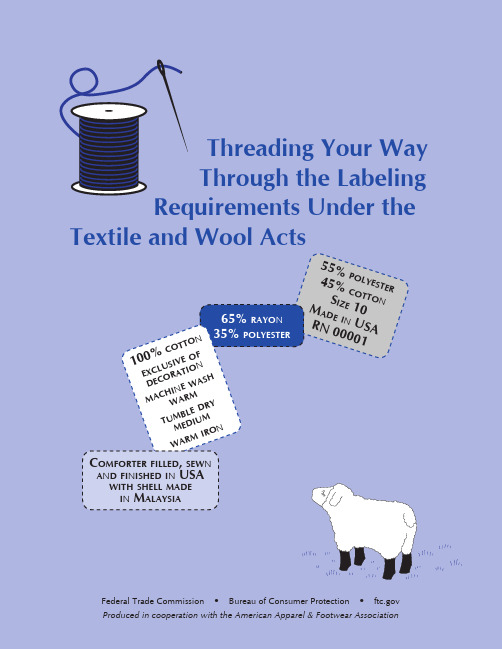
Federal Trade Commission
•
Bureau of Consumer Protection
•
Produced in cooperation with the American Apparel & Footwear Association
Dear Apparel or Textile Industry Member: The Federal Trade Commission (FTC) and the American Apparel & Footwear Association (AAFA) are pleased to provide you with a copy of the new and revised Threading Your Way Through the Labeling Requirements Under the Textile and Wool Acts. First published in 1998, this plain English handbook was very well received by members of the textile and apparel industry. It has now been reprinted with updated and additional information. Once again, the AAFA is proud to underwrite the costs of printing this publication. Threading Your Way will answer most of your questions about the three basic labeling requirements under the Textile and Wool Acts — fiber content, country of origin, and manufacturer or dealer identity. It contains many examples to illustrate correct labels. In addition, it briefly summarizes labeling requirements for fur products. Threading Your Way, as well as the full text of the rules and statutes, is available on the FTC’s Web site at — click on For Business, then Textile, Wool, Fur and Apparel Matters. To order additional copies, write: Consumer Response Center, Federal Trade Commission, Washington, DC 20580, or call: 1-877-FTC-HELP (1-877-382-4357); TDD: 202-326-2502. Sincerely yours,
美国商标法-合理使用相关法条-15USC1125

15 U.S.C. § 1125(a) Civil action(1) Any person who, on or in connection with any goods or services, or any container for goods, uses in commerce any word, term, name, symbol, or device, or any combination thereof, or any false designation of origin, false or misleading description of fact, or false or misleading representation of fact, which--(A) is likely to cause confusion, or to cause mistake, or to deceive as to theaffiliation, connection, or association of such person with another person, or as to the origin, sponsorship, or approval of his or her goods, services, or commercialactivities by another person, or(B) in commercial advertising or promotion, misrepresents the nature,characteristics, qualities, or geographic origin of his or her or another person'sgoods, services, or commercial activities,shall be liable in a civil action by any person who believes that he or she is or is likely to be damaged by such act.(2) As used in this subsection, the term “any person” includes any State, instrumentality of a State or employee of a State or instrumentality of a State acting in his or her official capacity. Any State, and any such instrumentality, officer, or employee, shall be subject to the provisions of this chapter in the same manner and to the same extent as any nongovernmental entity.(3) In a civil action for trade dress infringement under this chapter for trade dress not registered on the principal register, the person who asserts trade dress protection has the burden of proving that the matter sought to be protected is not functional.(b) ImportationAny goods marked or labeled in contravention of the provisions of this section shall not be imported into the United States or admitted to entry at any customhouse of the United States. The owner, importer, or consignee of goods refused entry at any customhouse under this section may have any recourse by protest or appeal that is given under the customs revenue laws or may have the remedy given by this chapter in cases involving goods refused entry or seized.(c) Dilution by blurring; dilution by tarnishment(1) Injunctive reliefSubject to the principles of equity, the owner of a famous mark that is distinctive, inherently or through acquired distinctiveness, shall be entitled to an injunctionagainst another person who, at any time after the owner's mark has becomefamous, commences use of a mark or trade name in commerce that is likely to cause dilution by blurring or dilution by tarnishment of the famous mark, regardless of the presence or absence of actual or likely confusion, of competition, or of actual economic injury.(2) Definitions(A) For purposes of paragraph (1), a mark is famous if it is widely recognized by the general consuming public of the United States as a designation of source of the goods or services of the mark's owner. In determining whether a mark possesses the requisite degree of recognition, the court may consider all relevant factors, including the following:(i) The duration, extent, and geographic reach of advertising and publicityof the mark, whether advertised or publicized by the owner or thirdparties.(ii) The amount, volume, and geographic extent of sales of goods orservices offered under the mark.(iii) The extent of actual recognition of the mark.(iv) Whether the mark was registered under the Act of March 3, 1881, orthe Act of February 20, 1905, or on the principal register.(B) For purposes of paragraph (1), “dilution by blurring” is association arising from the similarity between a mark or trade name and a famous mark that impairs the distinctiveness of the famous mark. In determining whether a mark or trade name is likely to cause dilution by blurring, the court may consider all relevant factors, including the following:(i) The degree of similarity between the mark or trade name and thefamous mark.(ii) The degree of inherent or acquired distinctiveness of the famous mark.(iii) The extent to which the owner of the famous mark is engaging insubstantially exclusive use of the mark.(iv) The degree of recognition of the famous mark.(v) Whether the user of the mark or trade name intended to create anassociation with the famous mark.(vi) Any actual association between the mark or trade name and thefamous mark.(C) For purposes of paragraph (1), “dilution by tarnishment” is association arisingfrom the similarity between a mark or trade name and a famous mark that harmsthe reputation of the famous mark.(3) ExclusionsThe following shall not be actionable as dilution by blurring or dilution by tarnishment under this subsection:(A) Any fair use, including a nominative or descriptive fair use, or facilitation ofsuch fair use, of a famous mark by another person other than as a designation ofsource for the person's own goods or services, including use in connection with--(i) advertising or promotion that permits consumers to compare goods orservices; or(ii) identifying and parodying, criticizing, or commenting upon the famousmark owner or the goods or services of the famous mark owner.(B) All forms of news reporting and news commentary.(C) Any noncommercial use of a mark.(4) Burden of proofIn a civil action for trade dress dilution under this chapter for trade dress not registered on the principal register, the person who asserts trade dress protection has the burden of proving that--(A) the claimed trade dress, taken as a whole, is not functional and is famous; and(B) if the claimed trade dress includes any mark or marks registered on theprincipal register, the unregistered matter, taken as a whole, is famous separateand apart from any fame of such registered marks.(5) Additional remediesIn an action brought under this subsection, the owner of the famous mark shall be entitled to injunctive relief as set forth in section 1116 of this title. The owner of the famous mark shall also be entitled to the remedies set forth in sections 1117(a) and 1118 of this title, subject to the discretion of the court and the principles of equity if--(A) the mark or trade name that is likely to cause dilution by blurring or dilutionby tarnishment was first used in commerce by the person against whom theinjunction is sought after October 6, 2006; and(B) in a claim arising under this subsection--(i) by reason of dilution by blurring, the person against whom theinjunction is sought willfully intended to trade on the recognition of thefamous mark; or(ii) by reason of dilution by tarnishment, the person against whom theinjunction is sought willfully intended to harm the reputation of thefamous mark.(6) Ownership of valid registration a complete bar to actionThe ownership by a person of a valid registration under the Act of March 3, 1881, or the Act of February 20, 1905, or on the principal register under this chapter shall be a complete bar to an action against that person, with respect to that mark, that--(A)(i) is brought by another person under the common law or a statute of a State;and(ii) seeks to prevent dilution by blurring or dilution by tarnishment; or(B) asserts any claim of actual or likely damage or harm to the distinctiveness orreputation of a mark, label, or form of advertisement.(7) Savings clauseNothing in this subsection shall be construed to impair, modify, or supersede the applicability of the patent laws of the United States.(d) Cyberpiracy prevention(1)(A) A person shall be liable in a civil action by the owner of a mark, including a personal name which is protected as a mark under this section, if, without regard to the goods or services of the parties, that person(i) has a bad faith intent to profit from that mark, including a personal name whichis protected as a mark under this section; and(ii) registers, traffics in, or uses a domain name that--(I) in the case of a mark that is distinctive at the time of registration of thedomain name, is identical or confusingly similar to that mark;(II) in the case of a famous mark that is famous at the time of registrationof the domain name, is identical or confusingly similar to or dilutive ofthat mark; or(III) is a trademark, word, or name protected by reason of section 706 ofTitle 18 or section 220506 of Title 36.(B)(i) In determining whether a person has a bad faith intent described under subparagraph (a), a court may consider factors such as, but not limited to(I) the trademark or other intellectual property rights of the person, if any, in thedomain name;(II) the extent to which the domain name consists of the legal name of the person or a name that is otherwise commonly used to identify that person;(III) the person's prior use, if any, of the domain name in connection with thebona fide offering of any goods or services;(IV) the person's bona fide noncommercial or fair use of the mark in a siteaccessible under the domain name;(V) the person's intent to divert consumers from the mark owner's online location to a site accessible under the domain name that could harm the goodwillrepresented by the mark, either for commercial gain or with the intent to tarnish or disparage the mark, by creating a likelihood of confusion as to the source,sponsorship, affiliation, or endorsement of the site;(VI) the person's offer to transfer, sell, or otherwise assign the domain name to the mark owner or any third party for financial gain without having used, or havingan intent to use, the domain name in the bona fide offering of any goods orservices, or the person's prior conduct indicating a pattern of such conduct;(VII) the person's provision of material and misleading false contact informationwhen applying for the registration of the domain name, the person's intentionalfailure to maintain accurate contact information, or the person's prior conductindicating a pattern of such conduct;(VIII) the person's registration or acquisition of multiple domain names which the person knows are identical or confusingly similar to marks of others that aredistinctive at the time of registration of such domain names, or dilutive of famous marks of others that are famous at the time of registration of such domain names, without regard to the goods or services of the parties; and(IX) the extent to which the mark incorporated in the person's domain nameregistration is or is not distinctive and famous within the meaning of subsection(c) of this section.(ii) Bad faith intent described under subparagraph (A) shall not be found in any case in which the court determines that the person believed and had reasonable grounds to believe that the use of the domain name was a fair use or otherwise lawful.(C) In any civil action involving the registration, trafficking, or use of a domain name under this paragraph, a court may order the forfeiture or cancellation of the domain name or the transfer of the domain name to the owner of the mark.(D) A person shall be liable for using a domain name under subparagraph (A) only if that person is the domain name registrant or that registrant's authorized licensee.(E) As used in this paragraph, the term “traffics in” refers to transactions that include, but are not limited to, sales, purchases, loans, pledges, licenses, exchanges of currency, and any other transfer for consideration or receipt in exchange for consideration.(2)(A) The owner of a mark may file an in rem civil action against a domain name in the judicial district in which the domain name registrar, domain name registry, or other domain name authority that registered or assigned the domain name is located if(i) the domain name violates any right of the owner of a mark registered in thePatent and Trademark Office, or protected under subsection (a) or (c) of thissection; and(ii) the court finds that the owner--(I) is not able to obtain in personam jurisdiction over a person who wouldhave been a defendant in a civil action under paragraph (1); or(II) through due diligence was not able to find a person who would havebeen a defendant in a civil action under paragraph (1) by--(aa) sending a notice of the alleged violation and intent to proceedunder this paragraph to the registrant of the domain name at thepostal and e-mail address provided by the registrant to theregistrar; and(bb) publishing notice of the action as the court may directpromptly after filing the action.(B) The actions under subparagraph (A)(ii) shall constitute service of process.(C) In an in rem action under this paragraph, a domain name shall be deemed to have its situs in the judicial district in which(i) the domain name registrar, registry, or other domain name authority thatregistered or assigned the domain name is located; or(ii) documents sufficient to establish control and authority regarding thedisposition of the registration and use of the domain name are deposited with the court.(D)(i) The remedies in an in rem action under this paragraph shall be limited to a court order for the forfeiture or cancellation of the domain name or the transfer of the domain name to the owner of the mark. upon receipt of written notification of a filed, stamped copy of a complaint filed by the owner of a mark in a United States district court underthis paragraph, the domain name registrar, domain name registry, or other domain name authority shall(I) expeditiously deposit with the court documents sufficient to establish thecourt's control and authority regarding the disposition of the registration and useof the domain name to the court; and(II) not transfer, suspend, or otherwise modify the domain name during thependency of the action, except upon order of the court.(ii) The domain name registrar or registry or other domain name authority shall not be liable for injunctive or monetary relief under this paragraph except in the case of bad faith or reckless disregard, which includes a willful failure to comply with any such court order.(3) The civil action established under paragraph (1) and the in rem action established under paragraph (2), and any remedy available under either such action, shall be in addition to any other civil action or remedy otherwise applicable.(4) The in rem jurisdiction established under paragraph (2) shall be in addition to any other jurisdiction that otherwise exists, whether in rem or in personam.。
美国商标法
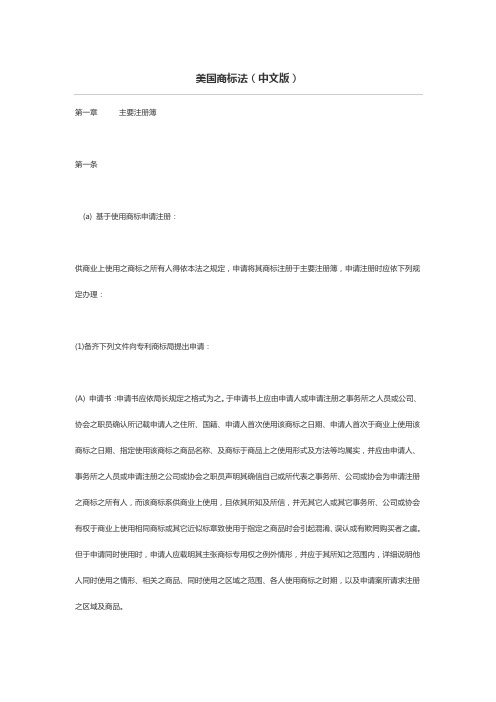
第一章主要注册簿第一条(a) 基于使用商标申请注册:供商业上使用之商标之所有人得依本法之规定,申请将其商标注册于主要注册簿,申请注册时应依下列规定办理:(1)备齐下列文件向专利商标局提出申请:(A) 申请书:申请书应依局长规定之格式为之。
于申请书上应由申请人或申请注册之事务所之人员或公司、协会之职员确认所记载申请人之住所、国籍、申请人首次使用该商标之日期、申请人首次于商业上使用该商标之日期、指定使用该商标之商品名称、及商标于商品上之使用形式及方法等均属实,并应由申请人、事务所之人员或申请注册之公司或协会之职员声明其确信自己或所代表之事务所、公司或协会为申请注册之商标之所有人,而该商标系供商业上使用,且依其所知及所信,并无其它人或其它事务所、公司或协会有权于商业上使用相同商标或其它近似标章致使用于指定之商品时会引起混淆、误认或有欺罔购买者之虞。
但于申请同时使用时,申请人应载明其主张商标专用权之例外情形,并应于其所知之范围内,详细说明他人同时使用之情形、相关之商品、同时使用之区域之范围、各人使用商标之时期,以及申请案所请求注册之区域及商品。
(B) 商标图样。
(C) 使用商标之样张或复制品。
所需检附样张或复制品之数量依局长之要求定之。
(2) 向专利商标局缴交注册费用。
(3) 遵照局长在不与法律抵触之范围内所发布之规则、办法。
(b)基于使用商标之意图申请注册凡善意欲于商业上使用商标者,且有情况足以显示其为善意时,得依本法申请注册于主要注册簿,申请时应依下列规定办理:(1) 备齐下列文件向专利商标局提出申请:(A) 申请书:申请书应依局长规定之格式为之。
申请书上应由申请人或申请注册之事务所之人员或公司、协会之职员确认所记载申请人之住所、国籍、申请人善意于商业上使用商标之意图,申请人将善意使用商标之商品,将来使用于商品上之商标形式及方法等均属实,并应由申请人,或申请注册之事务所之人员、或公司、协会之职员声明其确信自己或所代表之事务所、公司或协会有权于商业上使用该商标,且依其所知及所信,并无其它人或其它事务所、公司或协会有权于商业上使用相同商标或其它近似之标志,致使用于指定之商品时,会引起混淆、误认或有欺瞒购买者之虞。
美国商标法
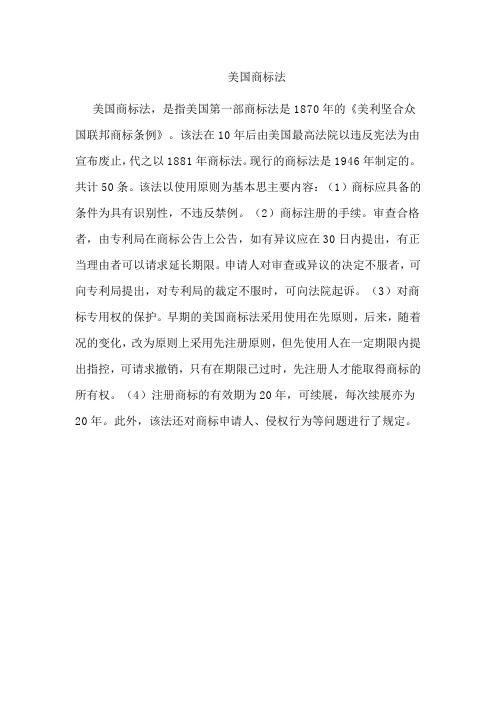
美国商标法
美国商标法,是指美国第一部商标法是1870年的《美利坚合众国联邦商标条例》。
该法在10年后由美国最高法院以违反宪法为由宣布废止,代之以1881年商标法。
现行的商标法是1946年制定的。
共计50条。
该法以使用原则为基本思主要内容:(1)商标应具备的条件为具有识别性,不违反禁例。
(2)商标注册的手续。
审查合格者,由专利局在商标公告上公告,如有异议应在30日内提出,有正当理由者可以请求延长期限。
申请人对审查或异议的决定不服者,可向专利局提出,对专利局的裁定不服时,可向法院起诉。
(3)对商标专用权的保护。
早期的美国商标法采用使用在先原则,后来,随着况的变化,改为原则上采用先注册原则,但先使用人在一定期限内提出指控,可请求撤销,只有在期限已过时,先注册人才能取得商标的所有权。
(4)注册商标的有效期为20年,可续展,每次续展亦为20年。
此外,该法还对商标申请人、侵权行为等问题进行了规定。
美国商标法 英文
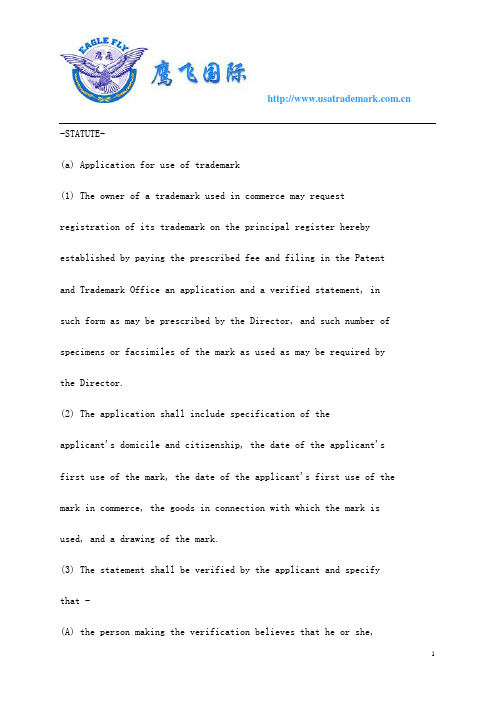
-STATUTE-(a) Application for use of trademark(1) The owner of a trademark used in commerce may requestregistration of its trademark on the principal register hereby established by paying the prescribed fee and filing in the Patentand Trademark Office an application and a verified statement, insuch form as may be prescribed by the Director, and such number of specimens or facsimiles of the mark as used as may be required bythe Director.(2) The application shall include specification of theapplicant's domicile and citizenship, the date of the applicant'sfirst use of the mark, the date of the applicant's first use of the mark in commerce, the goods in connection with which the mark is used, and a drawing of the mark.(3) The statement shall be verified by the applicant and specifythat -(A) the person making the verification believes that he or she, or the juristic person in whose behalf he or she makes the verification, to be the owner of the mark sought to beregistered;(B) to the best of the verifier's knowledge and belief, thefacts recited in the application are accurate;(C) the mark is in use in commerce; and(D) to the best of the verifier's knowledge and belief, noother person has the right to use such mark in commerce either inthe identical form thereof or in such near resemblance thereto asto be likely, when used on or in connection with the goods ofsuch other person, to cause confusion, or to cause mistake, or to deceive, except that, in the case of every application claiming concurrent use, the applicant shall -(i) state exceptions to the claim of exclusive use; and(ii) shall (!1) specify, to the extent of the verifier'sknowledge -(I) any concurrent use by others; (II) the goods on or in connection with which and the areasin which each concurrent use exists;(III) the periods of each use; and(IV) the goods and area for which the applicant desiresregistration.(4) The applicant shall comply with such rules or regulations asmay be prescribed by the Director. The Director shall promulgaterules prescribing the requirements for the application and for obtaining a filing date herein.(b) Application for bona fide intention to use trademark(1) A person who has a bona fide intention, under circumstances showing the good faith of such person, to use a trademark in commerce may request registration of its trademark on the principal register hereby established by paying the prescribed fee and filingin the Patent and Trademark Office an application and a verified statement, in such form as may be prescribed by the Director.(2) The application shall include specification of the applicant's domicile and citizenship, the goods in connection with which the applicant has a bona fide intention to use the mark, anda drawing of the mark.(3) The statement shall be verified by the applicant and specify -(A) that the person making the verification believes that he orshe, or the juristic person in whose behalf he or she makes the verification, to be entitled to use the mark in commerce;(B) the applicant's bona fide intention to use the mark in commerce;(C) that, to the best of the verifier's knowledge and belief,the facts recited in the application are accurate; and(D) that, to the best of the verifier's knowledge and belief,no other person has the right to use such mark in commerce eitherin the identical form thereof or in such near resemblance theretoas to be likely, when used on or in connection with the goods ofsuch other person, to cause confusion, or to cause mistake, or to deceive. Except for applications filed pursuant to section 1126 of thistitle, no mark shall be registered until the applicant has met the requirements of subsections (c) and (d) of this section.(4) The applicant shall comply with such rules or regulations asmay be prescribed by the Director. The Director shall promulgaterules prescribing the requirements for the application and for obtaining a filing date herein.(c) Amendment of application under subsection (b) to conform to requirements of subsection (a)At any time during examination of an application filed under subsection (b) of this section, an applicant who has made use ofthe mark in commerce may claim the benefits of such use forpurposes of this chapter, by amending his or her application tobring it into conformity with the requirements of subsection (a) of this section.(d) Verified statement that trademark is used in commerce(1) Within six months after the date on which the notice of allowance with respect to a mark is issued under section 1063(b)(2)of this title to an applicant under subsection (b) of this section, the applicant shall file in the Patent and Trademark Office,together with such number of specimens or facsimiles of the mark as used in commerce as may be required by the Director and payment ofthe prescribed fee, a verified statement that the mark is in use in commerce and specifying the date of the applicant's first use ofthe mark in commerce and those goods or services specified in the notice of allowance on or in connection with which the mark is usedin commerce. Subject to examination and acceptance of the statementof use, the mark shall be registered in the Patent and Trademark Office, a certificate of registration shall be issued for thosegoods or services recited in the statement of use for which themark is entitled to registration, and notice of registration shallbe published in the Official Gazette of the Patent and Trademark Office. Such examination may include an examination of the factorsset forth in subsections (a) through (e) of section 1052 of this title. The notice of registration shall specify the goods orservices for which the mark is registered.(2) The Director shall extend, for one additional 6-month period,the time for filing the statement of use under paragraph (1), upon written request of the applicant before the expiration of the 6- month period provided in paragraph (1). In addition to anextension under the preceding sentence, the Director may, upon a showing of good cause by the applicant, further extend the time for filing the statement of use under paragraph (1) for periods aggregating not more than 24 months, pursuant to written request of the applicant made before the expiration of the last extensiongranted under this paragraph. Any request for an extension underthis paragraph shall be accompanied by a verified statement thatthe applicant has a continued bona fide intention to use the markin commerce and specifying those goods or services identified inthe notice of allowance on or in connection with which theapplicant has a continued bona fide intention to use the mark in commerce. Any request for an extension under this paragraph shallbe accompanied by payment of the prescribed fee. The Director shall issue regulations setting forth guidelines for determining what constitutes good cause for purposes of this paragraph.(3) The Director shall notify any applicant who files a statementof use of the acceptance or refusal thereof and, if the statementof use is refused, the reasons for the refusal. An applicant may amend the statement of use.(4) The failure to timely file a verified statement of use under paragraph (1) or an extension request under paragraph (2) shallresult in abandonment of the application, unless it can be shown to the satisfaction of the Director that the delay in responding was unintentional, in which case the time for filing may be extended,but for a period not to exceed the period specified in paragraphs(1) and (2) for filing a statement of use.(e) Designation of resident for service of process and noticesIf the applicant is not domiciled in the United States the applicant may designate, by a document filed in the United States Patent and Trademark Office, the name and address of a personresident in the United States on whom may be served notices or process in proceedings affecting the mark. Such notices or process may be served upon the person so designated by leaving with that person or mailing to that person a copy thereof at the address specified in the last designation so filed. If the person so designated cannot be found at the address given in the last designation, or if the registrant does not designate by a document filed in the United States Patent and Trademark Office the name and address of a person resident in the United States on whom may be served notices or process in proceedings affecting the mark, such notices or process may be served on the Director.-SOURCE-(July 5, 1946, ch. 540, title I, Sec. 1, 60 Stat. 427; Pub. L. 87- 772, Sec. 1, Oct. 9, 1962, 76 Stat. 769; Pub. L. 93-596, Sec. 1, Jan. 2, 1975, 88 Stat. 1949; Pub. L. 100-667, title I, Sec. 103, Nov. 16, 1988, 102 Stat. 3935; Pub. L. 105-330, title I, Sec. 103,title II, Sec. 201(a)(1), Oct. 30, 1998, 112 Stat. 3064, 3069; Pub. L. 106-113, div. B, Sec. 1000(a)(9) [title IV, Sec. 4732(b)(1)(B)], Nov. 29, 1999, 113 Stat. 1536, 1501A-583; Pub. L. 107-273, div. C,title III, Sec. 13207(b)(1), (2), Nov. 2, 2002, 116 Stat. 1906.)-MISC1-PRIOR PROVISIONSSubsecs. (a) to (c) are from acts Feb. 20, 1905, ch. 592, Secs.1, 2, 33 Stat. 724; May 4, 1906, ch. 2081, Sec. 1, 34 Stat. 168; Feb. 18, 1909, ch. 144, 35 Stat. 628; Apr. 11, 1930, ch. 132, Sec.4, 46 Stat. 155; June 10, 1938, ch. 332, Sec. 1, 52 Stat. 638. Subsec. (d) is from act Feb. 20, 1905, ch. 592, Sec. 3, 33 Stat. 725.AMENDMENTS2002 - Subsec. (d)(1). Pub. L. 107-273, Sec. 13207(b)(1), infirst sentence, substituted "specifying the date of the applicant's first use of the mark in commerce and those goods or services specified in the notice of allowance on or in connection with which the mark is used in commerce." for "specifying the date of the applicant's first use of the mark in commerce and,, those goods or services specified in the notice of allowance on or in connectionwith which the mark is used in commerce."Subsec. (e). Pub. L. 107-273, Sec. 13207(b)(2), amended subsec.(e) generally. Prior to amendment, subsec. (e) required applicantnot domiciled in United States to designate name and address ofsome person resident in the United States on whom may be served notices or process in proceedings affecting the mark and providedthat notices or process be served by leaving with such person or mailing to him a copy, or upon Director if designated person cannotbe found.1999 - Subsecs. (a), (b), (d), (e). Pub. L. 106-113 substituted "Director" for "Commissioner" wherever appearing.1998 - Subsec. (a). Pub. L. 105-330, Sec. 103(a), amended subsec. (a) generally. Prior to amendment, subsec. (a) related to application by owner of a trademark used in commerce to registerthe trademark by filing in the Patent and Trademark Office awritten application in prescribed form and verified by applicant,by paying prescribed fee, and by complying with prescribed rules or regulations.Subsec. (b). Pub. L. 105-330, Sec. 103(b), amended subsec. (b) generally. Prior to amendment, subsec. (b) related to application,by person with bona fide intention, under circumstances showinggood faith, to use a trademark in commerce, to register trademarkby filing in the Patent and Trademark Office a written applicationin prescribed form and verified by applicant, by paying prescribed fee, and by complying with prescribed rules or regulations.Subsec. (d)(1). Pub. L. 105-330, Sec. 201(a)(1)(A), inserted "and," after "specifying the date of the applicant's first use ofthe mark in commerce".Pub. L. 105-330, Sec. 201(a)(1)(B), which directed the strikingout of "and, the mode or manner in which the mark is used on or in connection with such goods or services", was executed by strikingout ", and the mode or manner in which the mark is used on or in connection with such goods or services" after "notice of allowanceon or in connection with which the mark is used in commerce", to reflect the probable intent of Congress.Subsec. (d)(4). Pub. L. 105-330, Sec. 103(c), amended par. (4) generally. Prior to amendment, par. (4) read as follows: "Thefailure to timely file a verified statement of use under this subsection shall result in abandonment of the application."1988 - Subsec. (a). Pub. L. 100-667, Sec. 103(1) to (7), inserted "(a)" preceding introductory provisions and substituted "may applyto register his or her" for "may register his", redesignated former subsecs. (a) to (c) as pars. (1) to (3), respectively, redesignated former pars. (1) to (3) as subpars. (A) to (C), respectively, inpar. (1)(A), substituted "used on or in connection with" for"applied to" and "goods on or in connection" for "goods in connection", in par. (1)(C), struck out "actually" after "the mark as", and in par. (2), substituted "prescribed" for "filing". Subsecs. (b), (c). Pub. L. 100-667, Sec. 103(3), (9), addedsubsecs. (b) and (c) and redesignated former subsecs. (b) and (c)as pars. (2) and (3), respectively, of subsec. (a).Subsecs. (d), (e). Pub. L. 100-667, Sec. 103(8), (9), addedsubsec. (d) and redesignated former subsec. (d) as (e).1975 - Subsecs. (a), (b), (d). Pub. L. 93-596 substituted "Patentand Trademark Office" for "Patent Office".1962 - Subsec. (a)(1). Pub. L. 87-772 substituted "as to belikely, when applied to the goods of such other person, to cause confusion, or to cause mistake, or to deceive" for "as might be calculated to deceive", and struck out "or services" after "use by others, the goods".EFFECTIVE DATE OF 1999 AMENDMENTAmendment by Pub. L. 106-113 effective 4 months after Nov. 29,1999, see section 1000(a)(9) [title IV, Sec. 4731] of Pub. L. 106- 113, set out as a note under section 1 of Title 35, Patents. EFFECTIVE DATE OF 1998 AMENDMENTPub. L. 105-330, title I, Sec. 109(b), Oct. 30, 1998, 112 Stat. 3069, provided that: "This title [see Short Title of 1998 Amendment note below] and the amendments made by this title shall apply toany application for registration of a trademark pending on, orfiled on or after, the effective date of this Act [probably shouldbe "this title", see section 110 of Pub. L. 105-330, set out as an Effective Date of 1998 Amendment note below]."Pub. L. 105-330, title I, Sec. 110, Oct. 30, 1998, 112 Stat.3069, provided that: "This title [see Short Title of 1998 Amendment note below] and the amendments made by this title shall take effect-"(1) on the date that is 1 year after the date of the enactmentof this Act [Oct. 30, 1998], or"(2) upon the entry into force of the Trademark Law Treaty with respect to the United States [Aug. 12, 2000],whichever occurs first." Pub. L. 105-330, title II, Sec. 201(b), Oct. 30, 1998, 112 Stat. 3070, provided that: "The amendments made by this section [amending this section and sections 1052, 1057, 1064, 1091, 1094, 1113 to 1115, 1121, and 1124 of this title] shall take effect on the dateof enactment of this Act [Oct. 30, 1998], and shall apply only toany civil action filed or proceeding before the United StatesPatent and Trademark Office commenced on or after such daterelating to the registration of a mark."EFFECTIVE DATE OF 1988 AMENDMENTSection 136 of title I of Pub. L. 100-667 provided that: "Thistitle and the amendments made by this title [see Short Title of1988 Amendment note below] shall become effective on the date whichis one year after the date of enactment of this Act [Nov. 16, 1988]."EFFECTIVE DATE OF 1975 AMENDMENTAmendment by Pub. L. 93-596 effective Jan. 2, 1975, see section 4of Pub. L. 93-596, set out as a note under section 1111 of this title.。
商标法英文版

商标法英文版【原创实用版】目录1.商标法的定义和作用2.商标法的基本原则3.商标注册的流程4.商标权的保护和侵权处理5.商标法的国际合作正文商标法是一部关于商标注册和管理的法律,它的主要目的是保护商标所有者的权益,防止他人在未经授权的情况下使用相同的商标,从而避免混淆和误解。
商标法在全球范围内得到了广泛的应用和认可,它为商标所有者提供了一个法律框架,使他们可以在法律的保护下维护自己的商标权益。
商标法的基本原则包括公平原则、诚实信用原则、优先权原则等。
公平原则要求商标注册应当公平公正,不得歧视任何一方;诚实信用原则要求商标所有者应当遵循诚实信用的原则,不得欺骗消费者;优先权原则则规定了商标注册的优先权,即在某些情况下,先申请商标注册的人可以获得商标权。
商标注册的流程包括申请、审查、公示和注册等步骤。
申请人需要提交商标注册申请,并提供相关证明文件和资料。
商标局会对申请进行审查,以确定商标是否符合商标法的规定。
如果商标符合规定,商标局会将其公示,以便公众提出异议。
如果公示期满后没有异议,商标局将授予商标权并注册商标。
商标权是商标所有者的一种权利,它允许商标所有者使用商标,并防止他人在未经授权的情况下使用相同的商标。
如果他人侵犯了商标权,商标所有者可以采取法律手段进行维权。
商标侵权的处理方式包括要求停止侵权行为、赔偿损失等。
随着全球化的发展,商标法在国际范围内也得到了广泛的应用和合作。
商标法的国际合作包括签订国际协议、建立国际组织等,这些合作有助于促进商标法的发展和完善,也有助于商标所有者更好地维护自己的商标权益。
总之,商标法是一部关于商标注册和管理的法律,它的主要目的是保护商标所有者的权益。
美国法典 第22章 商标

美国法典第22章商标〈按1988年商标法修改法案(公法100-667, 1988年11月16日)最后修正〉I主注册簿1051.注册;申请;交费;为送达程序处理文件和通知书指定常驻代表1052.可在主注册簿上注册的商标;并存注册1053.服务商标可予注册1054.集体商标和证明商标可予注册1055.由有关公司使用影响有效性和注册1056.放弃不能注册的内容1057.注册证1058.注册有效期;撤销;连续使用保证书;局长意见通知书1059.续展注册1060.商标转让;履行手续;备案;未经通知的购买人1061.承认书和证明书的签署手续 1062.公告;驳回注册的程序;依先前法案注册的商标的重新公告 1063.对注册异议1064.撤销注册1065.在某些条件下,商标使用权的不容置疑性1066.抵触;由局长宣布1067.抵触、异议、以及关于并存使用注册或请求撤销的诉讼;通知;商标审理和上诉委员会1068.同上;局长的审理意见1069.在当事人之间诉讼中,衡平法原则的应用1070.向商标审理和上诉委员会提出对审查员决定的上诉1071.向法院上诉1072.注册即所有权要求的推定通知Ⅱ.副注册簿1091.可在副注册簿上注册的商标;注册申请和程序;商标性质;在对外商务中使用的商标1092.公告;不受异议;撤销1093.主注册簿和副注册簿的商标注册证不同1094.本章可适用于副注册簿上注册的条款1095.不排除在主注册簿上注册1096.在副注册簿上的注册不能用以阻止进口Ⅲ.一般条款1111.注册通告;在商标上展示;在侵权诉讼中追索权益和赔偿1112.商品和服务分类;在多个类别上注册1113.费用1114.补救;侵权;印刷和出版商无知侵权1115.在主注册簿上的注册为商标专用权的证据;辩护 1116.禁令;执行;通知局长1117.对侵犯权利的追索;收益、损害赔偿和诉讼费;律师费1118.销毁侵权物品1119.法院对注册的权力1120.对虚假的或欺骗性的注册所负民事责任1121.联邦法院的管辖权1122.各州、州的机关和州的官员的责任1123.专利商标局内的程序实施规章条例1124.禁止进口带有侵权商标或名称的商品1125.虚假的原产地标记、虚假的描述和淡化1126.国际公约1127.解释和定义;本章目的Ⅰ.主注册簿1051.注册;申请;交费;为送达程序处理文件和通知书指定常驻代表[第1条](a)用于商业的商标的所有人可依本章申请在本法建立的主注册簿上注册其商标:(1)向专利商标局提交--(A)一份申请书,按照局长规定的格式,经由申请人或申请单位的官员签署作证,写明申请人的住址和公民身份、申请人第一次使用该商标的日期、申请人在商业上第一次使用该商标的日期、使用该商标的有关商品和有关此类商品使用该商标的方式,并包括作证人的声明,证明确信其本人或其所代表的公司或机构确系申请注册的商标的所有人,并且该商标确系正在商业中使用,并且据其所知和相信,无他人有权在商业中使用与该商标相同或相似的商标,以致该他人在所述有关商品的使用可能引起混淆、误认或欺骗的情况;倘若是提出并存使用要求的申请,申请人应阐明有关其专用权要求的例外情况,应据其所知说明他人并存使用的情况、现有的并存使用的有关商品、并存使用的领域、每一使用的期限,以及申请人拟注册的商品和领域;(B)该商标的图样;(C)按局长要求的份数提交该商标的使用样品或精确复制品。
美国商标侵权标准

美国商标侵权标准一、在美国,判断商标侵权的最基本的标准一个商标的拥有权,是由商标的注册时间先后决定的。
也就是说,谁先使用一个商标,谁就拥有该商标。
因此,判断一个商标是否侵犯另一个商标的权利,就看谁先使用这个商标。
但是,并不是任何两个相同的商标都不允许同时存在。
这时,判断商标是否侵权的另一个标准是,新商标的出现是否会让第一个商标的客户错误地把第二个相同的商标当成第一个商标。
如果两个商标是在完全不同的行业或不同的地区,有着不同的顾客群,并且有着不同的销售渠道,那两个相同的商标是可以同时存在的。
但是,这一判断标准对哪些著名的商标并不适用。
比如说,如果您使用麦当劳的商标甚至是相似的图案去卖汽车,这看起来似乎与麦当劳卖的快餐风马牛毫不相干,法庭仍然会判您侵权。
事实上,即使是法庭最终的判决对您有利,您也很难有精力和财力与一家大公司在法庭上周旋,等到法官判决的那一天。
所以说,在选择美国商标时的一个重要原则,就是要避免与任何著名的商标相似。
否则的话,会给您带来无穷的麻烦。
美国是世界上较早制定商标法的国家,美国较早的商标保护是由法院根据普通法对未注册的商标保护进行判决。
1837年,马萨诸塞州法院开始受理有关商标的诉讼案件。
联邦法院从1844年开始受理英国制造商控告一美国公民侵害其商标的诉讼案件。
在侵权诉讼当中,合理的法律依据是判断被告方的商标是否侵犯了原告方的商标权首先要考虑的问题。
对此,美国的联邦商标法——《兰哈姆法》绐出了清楚的界定。
美国国会在制定《兰哈姆法》时明确指出防止消费者混淆是其主要的立法目的。
在这种立法思想的指导下,《兰哈姆法》第2条、第32条和第43条将导致消费者混淆、误认或欺骗,作为驳回商标注册申请或构成商标侵权的事由。
美国《兰哈姆法》第2条规定:凡可用以识别申请人物品与他人物品的商标都不应因其性质拒绝按主要注册簿予以注册,但有下列情形之一者除外:......(四)包含有与他人已在专利与商标局注册的某一标志十分相似的标志,或者是他人在美国已经在先使用并且尚未放弃的某一标志或商号,而一旦在申请人的物品上使用有可能引起混淆、误解或欺骗。
美国商标法

美国商标法美国商标法是美国最重要的商标法律,旨在保护商标权利,以确保商标使用者们能够享有专利权利,注册商标,而且可以维护这些商标权利。
美国商标法处理的三个主要内容是商标的注册,智慧知识产权的保护,以及非法的商标使用的惩罚。
一般来说,美国商标法在一定程度上有助于保护商品和服务的专有权。
同时,美国商标法也允许某些受过保护的专有名称或标志的使用,以确保此类标志的使用不会威胁到其他商家参与此领域交易的权利。
美国商标法是由美国联邦政府制定的,由美国司法部负责实施和监督。
美国法律中现有的所有商标权利都是基于其法律,而有关其他国家的商标法也是遵循其规定来保护涉及商标的权利。
美国商标法主要由《商标法》第15章和《商标处理法》第30章组成,它们构成美国商标法的核心部分。
《商标法》第15章规定,商标的注册者将享有某种特殊的专有权,可以保护其标志免受商标侵权的侵害。
而《商标处理法》第30章则保证了一旦商标权利被侵犯,正确的措施将会向侵权者施加法律制裁,以确保有关商标权利不会被滥用。
美国商标法要求每个注册商标都要满足一定的要求:商标必须可区分,不能与现有的注册商标相似,拥有者也必须按实际情况使用该商标;同时,法律要求商标不能与他人所拥有的已有商标相似。
此外,商标的拥有者还必须向美国商标局提出书面申请,以获得商标注册,美国商标局有权根据相关条件来决定是否注册。
商标法的执行机关是美国商标局,它负责商标的注册,受理各种商标纠纷,以及商标相关的许可和复审等事宜。
该局拥有处理和审查商标申请的权利,也有起诉不当使用他人商标权利的权力,并且可以授予给商标拥有者使用法律手段维护其商标权利的权利。
此外,美国商标法规定,非法的商标使用者将面临严厉的惩罚,包括罚金、犯罪责任,乃至被拘留和监禁等。
美国商标法旨在净化商标市场,以确保商标的公平竞争,以避免商标权利的滥用,从而保护商品和服务的真实性,从而获得消费者的信任。
总之,美国商标法旨在加强商标在产品和服务中的特殊身份,保护消费者免受不正当竞争,同时也有助于维护商标拥有者的专有权利。
商标法英文版
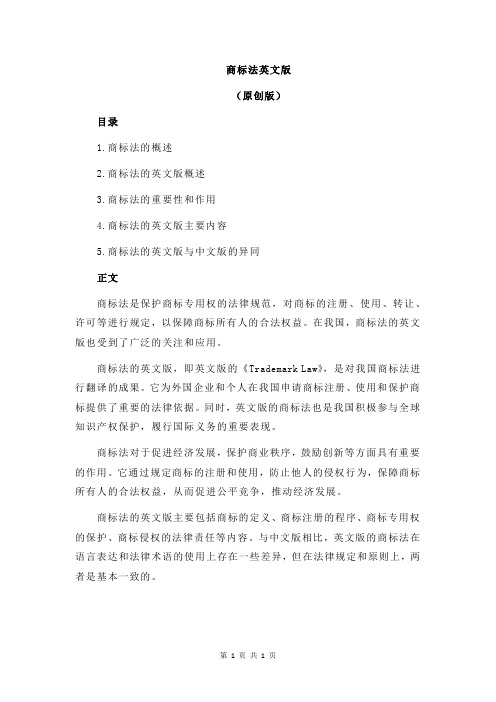
商标法英文版
(原创版)
目录
1.商标法的概述
2.商标法的英文版概述
3.商标法的重要性和作用
4.商标法的英文版主要内容
5.商标法的英文版与中文版的异同
正文
商标法是保护商标专用权的法律规范,对商标的注册、使用、转让、许可等进行规定,以保障商标所有人的合法权益。
在我国,商标法的英文版也受到了广泛的关注和应用。
商标法的英文版,即英文版的《Trademark Law》,是对我国商标法进行翻译的成果。
它为外国企业和个人在我国申请商标注册、使用和保护商标提供了重要的法律依据。
同时,英文版的商标法也是我国积极参与全球知识产权保护,履行国际义务的重要表现。
商标法对于促进经济发展,保护商业秩序,鼓励创新等方面具有重要的作用。
它通过规定商标的注册和使用,防止他人的侵权行为,保障商标所有人的合法权益,从而促进公平竞争,推动经济发展。
商标法的英文版主要包括商标的定义、商标注册的程序、商标专用权的保护、商标侵权的法律责任等内容。
与中文版相比,英文版的商标法在语言表达和法律术语的使用上存在一些差异,但在法律规定和原则上,两者是基本一致的。
第1页共1页。
美国兰汉姆(商标)法

美国兰汉姆(商标)法目录Ⅰ.主注册簿1051.注册申请;证明(a)已使用商标的申请(b)有真诚的意图使用商标的申请(c)为达到(a)款的要求,根据(b)款进行的申请修改(d)已在商业中使用该商标的已宣誓之声明(e)为送达传票和通知指定某居民1052.可在主注册薄上注册的商标;并存注册1053.服务商标可予注册1054.集体商标和证明商标可予注册1055.关联公司的使用将影响有效性和注册1056.不能注册内容的声明放弃(a)强制的和主动的放弃(b)权利的损害1057.注册证(a)颁发和格式(b)注册证作为表面成立之证据(c)商标的注册申请作为其推定使用(d)向受让人颁发注册证(e)注册人的放弃、撤销或修改(f)以专利商标局记录的复印件为证据(g)专利商标局错误的更正(h)申请人错误的更正1058.有效期(a)一般情况(b)连续使用宣誓书(c)递交的宽展期;不规范(d)宣誓书要求的通知(e)宣誓书的接受或驳回通知(f)为送达传票和通知指定某居民1059.注册的续展(a)续展的期限;续展的时间(b)续展的驳回通知(c)为送达传票和通知指定某居民1060.转让1061.承认书和证明书的签署1062.公告(a)审查和公告(b)注册的驳回;申请的修改;放弃(c)依据修改前的法案注册的商标重新公告1063.注册的异议1064.注册的撤销1065.在某些条件下使用商标的不容置疑的权利1066.抵触;专利商标局局长声明1067.抵触、异议以及并存使用注册或撤销的程序;通知;商标审判和上诉委员会1068.专利商标局局长在抵触、异议以及并存使用注册或撤销程序中的职权1069.在双方当事人参加的程序中衡平法原则的应用1070.不服审查员的决定向商标审判和上诉委员会提出上诉1071.向法院上诉(a)有权上诉的人;美国联邦巡回上诉法院;民事诉讼的放弃;另一方当事人对民事诉讼的选择权;程序(b)民事诉讼;权利人;法院的管辖权;专利商标局局长的地位;程序1072.注册作为所有权要求的推定通知Ⅱ.辅注册簿1091.辅注册簿(a)可注册的商标(b)申请和注册的程序(c)商标的性质1092.公告;不能被提异议;撤销1093.在主注册簿和辅注册簿上注册商标的注册证不同1094.本法可适用于在辅注册簿上注册的规定1095.不排除在主注册簿上注册1096.在辅注册簿上的注册不能用来阻止进口Ⅲ.一般条款1111.注册的标注;在商标上展示;在侵权诉讼中追索权益和赔偿1112.商品和服务的分类;多类注册1113.费用(a)申请;服务;材料(b)放弃;印第安产品1114.救济;侵权;印刷和出版商的非故意侵权1115.在主注册簿上的注册作为商标专用权的证据;辩护(a)证据价值;辩护(b)不容置疑性;辩护1116.强制性救济(a)管辖;送达(b)法院文件证明文本的转发(c)通知专利商标局局长(d)由使用仿冒商标引起的民事诉讼1117.对被侵犯权利的补偿(a)收益、损害和诉讼费;律师费(b)使用仿冒商标的三倍损害赔偿(c)使用仿冒商标的法定损害赔偿(d)本法第1125条(d)(1)款规定侵权的法定损害赔偿1118.销毁侵权物品1119.法院对注册的权力1120.虚假或欺骗性注册的民事责任1121.联邦法院的管辖权;州和地方政府要求改变注册商标或以不同的形式展示;禁止1122.美国,各州,及其机关和官员的责任(a)美国放弃国家豁免权(b)各州放弃豁免权(c)救济1123.专利商标局进行程序处理的规章条例1124.禁止进口带有侵权商标或名称的商品1125.禁止虚假的原产地标示、虚假的描述和淡化(a)民事诉讼(b)进口(c)知名商标淡化的救济(d)域名抢注的防范1126.国际条约(a)由国际局传送来商标的注册簿(b)原属国为公约或条约成员国的公民可享受本条规定的权益(c)在原属国的在先注册;原属国的定义(d)优先权(e)在主注册簿或辅注册簿上的注册;外国注册证副本(f)国内注册独立于外国注册(g)外国公民的商号或商业名称不经注册即受保护(h)保护外国公民不受到不公平的竞争(i)美国公民和居民有权享受本条的权益1127.解释和定义;本章目的1128.国家知识产权执法协调委员会(a)设立(b)职责(c)所需的商议(d)不可减损(e)报告(f)资金1129.域名抢注中对个人的保护(1)一般规定(A)民事责任(B)除外条款(2)救济(3)定义(4)生效日期IV.马德里议定书1141.定义(1)基础申请(2)基础注册(3)缔约方(4)登记日期(5)有真诚的意图在商业中使用商标的声明(6)延伸保护(7)国际注册的所有人(8)国际申请(9)国际局(10)国际注册簿(11)国际注册(12)国际注册日期(13)马德里议定书(14)驳回通知书(15)缔约方的主管局(16)原属局(17)异议期限1141a.基于在美国的申请和注册的国际申请(a)一般条款(b)有资格的所有人1141b.国际申请的证明(a)证明程序(b)传送1141c.基础申请和基础注册的限制、放弃、撤销和到期1141d.在国际注册之后的延伸保护请求1141e.基于马德里议定书将国际注册的保护延伸至美国1141f.提交请求将国际注册的保护延伸至美国的效力1141g.请求延伸保护至美国的优先权1141h.延伸保护请求的审查和异议;驳回通知1141i.延伸保护的效力1141j.在美国的延伸保护对作为其基础的国际注册的依附性1141k.宣誓书和费用1141l.延伸保护的转让1141m.不容置疑性1141n.延伸保护的权利Ⅰ.主注册簿1051注册申请;证明(a)已使用商标的申请(1)通过交纳规费,按照专利商标局局长规定的格式向专利商标局递交一份申请和一份已宣誓之声明,按专利商标局局长要求的份数提交该商标的使用图样或复制品,将该商标使用于商业的所有人可申请在依本法建立的主注册簿上注册其商标。
美国商标法规定有什么-

美国商标法规定有什么?“商标”包括文字、名称、符号、图形或者其组合,由制造者或者商人用以识别其商品,以区别于他人生产或者销售者。
美国商标含意包括服务商标、集体商标和保证商标。
商标可以是平面视觉商标,也可以是立体的(三维)视觉商标,也允许音响商标即听觉商标注册。
▲一、美国商标法规定有什么?“商标”包括文字、名称、符号、图形或者其组合,由制造者或者商人用以识别其商品,以区别于他人生产或者销售者。
美国商标含意包括服务商标、集体商标和保证商标。
商标可以是平面视觉商标,也可以是立体的(三维)视觉商标,也允许音响商标即听觉商标注册。
1.申请基础。
美国对商标专用权的确立采用使用在先的原则,一个商标只要投入商业使用,即使没有注册,也拥有商标专用权,在发生商标专用权争议时,美国专利局将裁定商标专用权属于最先使用者。
除使用在先原则外,下列条件也可成为在美国申请商标注册的基础:(1)意向使用,即申请人有打算在美国使用的真实意图。
(2)原属国申请。
虽然申请人在本国已申请注册,而尚未获准注册,但必须已取得申请日期和申请号。
(3)原属国注册,即已在本国取得商标注册证。
2.申请人资格。
无论商标所有人为个人、公司、商号或社会团体,均可申请商标注册。
凡在美国有固定住所或工商企业的外国人,可按本国人同等待遇,对其他外国人,一般按对等原则处理。
不居住于美国的商标申请人,需委托代理人代为办理。
3.禁用条款。
任何用文字、符号或标志,或这些事物的组合作为商标,以区别申请人的产品而不违禁例者,均可予以注册,但下列内容不能作为商标注册:(1)含有不道德、欺骗或丑恶的事物,或者含有个人组织、信仰或国家象征进行诽谤或虚伪和它们的关系使之丧失信誉的事务。
(2)含有合众国或某一州、市或某一外国的旗帜、国徽或其他徽章,或其他仿制品。
(3)未经本人书面同意,使用在世的某人姓名、肖像或签字式样者;或美国某一已故总统的夫人仍健在时,使用该已故总统的姓名、遗像或签字式样,而未经总统夫人书面同意者。
美国商标使用

美国商标法中关于“商标使用”的规定非常严格,不仅只有已经在美国使用的商标才能最终获得注册,而且对于注册成功的商标也有强制使用的规定,否则注册商标也会被美国专利商标局主动撤销。
那么美国专利商标局又如何掌控商标是否有在美国合法的使用呢?其主要途径是要求商标申请人或注册人定期向美国专利商标局提交商标所附之商品/服务在美国使用的证据。
本篇文章将围绕商标使用证据着重介绍提交的时间、方式以及注意事项。
一、提交使用证据的几种情况依据美国商标法,从提交商标申请开始到商标续展时一共需要提交三次商标的使用证据。
按照美国商标申请注册的流程,我们可以将其分为三个阶段,即商标申请中、商标注册后以及商标续展时。
1、商标申请中提交美国商标申请有三个基础,即“基于打算使用”(ITU,Intent to use),“基于已经使用”(USE),或者“基于一项国外注册”(A foreign registration)。
选择不同的提交基础,其对于使用证据的规定和要求也不尽相同。
具体如下:(一)“基于打算使用”(ITU,Intent to use)1)时间:商标申请通过审查并公告且无人提出异议,此时美国专利商标局将下发授权通知(Notice of Allowance)。
从下发授权通知之日起6个月需要提交使用证据。
最长时间为从下发授权通知之日起三年。
2)延期以及要求:如果申请人此时还没有将商标在美国使用或者暂时提供不了使用证据,可以在限届满前向美国专利商标局提出延期申请,每次延期请求可以获得额外6个月期限,理论上共可以延期5次。
但是在实践中随着延期次数的增加,审查员对于申请人延期请求的审核也越来越严格。
比如,申请人提出的第一次延期请求不需要提供任何理由,但是从第二次延期开始,申请人均需要提供合理的延期理由。
通常情况下,审查员很难核准超过24个月的延期。
3)后果:商标使用证据必须提交,未提交视为放弃申请。
(二)“基于已经使用”(USE)以“已经使用”为基础提交的美国申请,必须在申请时一并提交使用证据,否则美国专利商标局不会受理商标申请。
美国商标法
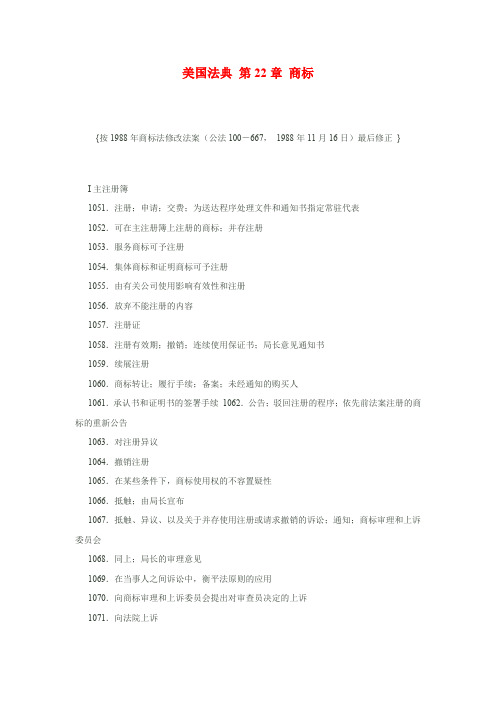
美国法典第22章商标{按1988年商标法修改法案(公法100-667,1988年11月16日)最后修正}I主注册簿1051.注册;申请;交费;为送达程序处理文件和通知书指定常驻代表1052.可在主注册簿上注册的商标;并存注册1053.服务商标可予注册1054.集体商标和证明商标可予注册1055.由有关公司使用影响有效性和注册1056.放弃不能注册的内容1057.注册证1058.注册有效期;撤销;连续使用保证书;局长意见通知书1059.续展注册1060.商标转让;履行手续;备案;未经通知的购买人1061.承认书和证明书的签署手续1062.公告;驳回注册的程序;依先前法案注册的商标的重新公告1063.对注册异议1064.撤销注册1065.在某些条件下,商标使用权的不容置疑性1066.抵触;由局长宣布1067.抵触、异议、以及关于并存使用注册或请求撤销的诉讼;通知;商标审理和上诉委员会1068.同上;局长的审理意见1069.在当事人之间诉讼中,衡平法原则的应用1070.向商标审理和上诉委员会提出对审查员决定的上诉1071.向法院上诉1072.注册即所有权要求的推定通知Ⅱ.副注册簿1091.可在副注册簿上注册的商标;注册申请和程序;商标性质;在对外商务中使用的商标1092.公告;不受异议;撤销1093.主注册簿和副注册簿的商标注册证不同1094.本章可适用于副注册簿上注册的条款1095.不排除在主注册簿上注册1096.在副注册簿上的注册不能用以阻止进口Ⅲ.一般条款1111.注册通告;在商标上展示;在侵权诉讼中追索权益和赔偿1112.商品和服务分类;在多个类别上注册1113.费用1114.补救;侵权;印刷和出版商无知侵权1115.在主注册簿上的注册为商标专用权的证据;辩护1116.禁令;执行;通知局长1117.对侵犯权利的追索;收益、损害赔偿和诉讼费;律师费1118.销毁侵权物品1119.法院对注册的权力1120.对虚假的或欺骗性的注册所负民事责任1121.联邦法院的管辖权1122.各州、州的机关和州的官员的责任1123.专利商标局内的程序实施规章条例1124.禁止进口带有侵权商标或名称的商品1125.虚假的原产地标记、虚假的描述和淡化1126.国际公约1127.解释和定义;本章目的Ⅰ.主注册簿1051.注册;申请;交费;为送达程序处理文件和通知书指定常驻代表[第1条](a)用于商业的商标的所有人可依本章申请在本法建立的主注册簿上注册其商标:(1)向专利商标局提交--(A)一份申请书,按照局长规定的格式,经由申请人或申请单位的官员签署作证,写明申请人的住址和公民身份、申请人第一次使用该商标的日期、申请人在商业上第一次使用该商标的日期、使用该商标的有关商品和有关此类商品使用该商标的方式,并包括作证人的声明,证明确信其本人或其所代表的公司或机构确系申请注册的商标的所有人,并且该商标确系正在商业中使用,并且据其所知和相信,无他人有权在商业中使用与该商标相同或相似的商标,以致该他人在所述有关商品的使用可能引起混淆、误认或欺骗的情况;倘若是提出并存使用要求的申请,申请人应阐明有关其专用权要求的例外情况,应据其所知说明他人并存使用的情况、现有的并存使用的有关商品、并存使用的领域、每一使用的期限,以及申请人拟注册的商品和领域;(B)该商标的图样;(C)按局长要求的份数提交该商标的使用样品或精确复制品。
商标法 英文版

商标法英文版
商标法,是指规定商标的注册、使用和保护的法律法规,它是保护商业市场秩序、促进经济发展的重要法律。
商标是企业在市场经济中的重要标志和财产,也是企业对消费者进行品牌宣传的重要手段。
商标的注册是保障企业合法权益和防范不正当竞争的重要方式。
商标法为商标的注册提供了严格的程序和标准,确保商标的真实性、合法性和有效性。
商业市场的竞争越来越激烈,商标也越来越受到重视。
商标法对商标的保护范围做出了明确规定,禁止他人在同类或近似类别的商品或服务上进行侵权行为。
商标的侵权会损害商标权人的经济利益和商业信誉,对商业市场的健康发展产生不良影响。
商标法还规定了商标权人的权利和义务,强化了商标权保护的力度。
商标权人不仅有权制止他人侵权,也有责任维护商标的品牌形象和质量。
商标法对商标的使用期限和续展等方面做出规定,方便商标权人维护商标的合法权益和稳定经营。
商标法在维护商业市场秩序、保护知识产权方面发挥重要作用。
企业应当依法注册商标、规范使用商标,做好商标的维护和保护工作。
消费者要树立商标意识,维护商标权人的合法权益。
商标法的实施需要广大社会各界的共同努力,共同营造公平竞争、创新发展的商业环境。
- 1、下载文档前请自行甄别文档内容的完整性,平台不提供额外的编辑、内容补充、找答案等附加服务。
- 2、"仅部分预览"的文档,不可在线预览部分如存在完整性等问题,可反馈申请退款(可完整预览的文档不适用该条件!)。
- 3、如文档侵犯您的权益,请联系客服反馈,我们会尽快为您处理(人工客服工作时间:9:00-18:30)。
第一章主要注册簿第一条(a) 基于使用商标申请注册:供商业上使用之商标之所有人得依本法之规定,申请将其商标注册于主要注册簿,申请注册时应依下列规定办理:(1)备齐下列文件向专利商标局提出申请:(A) 申请书:申请书应依局长规定之格式为之。
于申请书上应由申请人或申请注册之事务所之人员或公司、协会之职员确认所记载申请人之住所、国籍、申请人首次使用该商标之日期、申请人首次于商业上使用该商标之日期、指定使用该商标之商品名称、及商标于商品上之使用形式及方法等均属实,并应由申请人、事务所之人员或申请注册之公司或协会之职员声明其确信自己或所代表之事务所、公司或协会为申请注册之商标之所有人,而该商标系供商业上使用,且依其所知及所信,并无其它人或其它事务所、公司或协会有权于商业上使用相同商标或其它近似标章致使用于指定之商品时会引起混淆、误认或有欺罔购买者之虞。
但于申请同时使用时,申请人应载明其主张商标专用权之例外情形,并应于其所知之范围内,详细说明他人同时使用之情形、相关之商品、同时使用之区域之范围、各人使用商标之时期,以及申请案所请求注册之区域及商品。
(B) 商标图样。
(C) 使用商标之样张或复制品。
所需检附样张或复制品之数量依局长之要求定之。
(2) 向专利商标局缴交注册费用。
(3) 遵照局长在不与法律抵触之范围内所发布之规则、办法。
(b)基于使用商标之意图申请注册凡善意欲于商业上使用商标者,且有情况足以显示其为善意时,得依本法申请注册于主要注册簿,申请时应依下列规定办理:(1) 备齐下列文件向专利商标局提出申请:(A) 申请书:申请书应依局长规定之格式为之。
申请书上应由申请人或申请注册之事务所之人员或公司、协会之职员确认所记载申请人之住所、国籍、申请人善意于商业上使用商标之意图,申请人将善意使用商标之商品,将来使用于商品上之商标形式及方法等均属实,并应由申请人,或申请注册之事务所之人员、或公司、协会之职员声明其确信自己或所代表之事务所、公司或协会有权于商业上使用该商标,且依其所知及所信,并无其它人或其它事务所、公司或协会有权于商业上使用相同商标或其它近似之标志,致使用于指定之商品时,会引起混淆、误认或有欺瞒购买者之虞。
但如系依四十四条之规定申请注册时,申请人须符合本条第(d)项之规定,始可注册。
(B) 商标图样。
(2) 向专利商标局缴交注册费用。
(3) 遵照局长在不与法律抵触之范围内所发布之规则、办法。
(c) 基于使用商标之意图申请注册—主张使用利益申请人依第(b)项规定所为之注册申请,如于审核阶段已于商业上使用该商标时,得修改注册之申请,使符合第(a)项之规定,以主张其依本法之意旨使用商标之利益。
(d) 基于使用商标之意图申请注册—使用之陈述(1) 依第(b)项规定提出注册申请之申请人,于收到专利商标局依十三条(b)项款规定所发给之商标核准通知后六个月内应检具于商业上使用该商标之样张或复制品,其数量依局长之要求定之,以及应缴费用和经确认声明文书向专利商标局提出申请。
声明文书上应记载该商标已供商业上使用、申请人第一次于商业上使用该商标已供商业上使用、申请人第一次于商业上使用该商标之日期、记载于核准通知上应于商业上使用商标之商品或服务、申请人使用与商品、服务有关之商标之形式或方法等,使用声明书经审核通过后,专利商标局应准该商标注册,并发给载明使用声明书上所述该注册商标将使用之商品或服务之注册登记证。
注册通知应刊载于专利商标局之公报。
使用声明书之审核应包括第二条第(a)项至第(e)项所列各点之审查。
注册通知应详细记载注册商标所指定使用之商品或服务。
(2) 于前款所述六个月期满前,申请人提出延展依第款提出使用声明书期限之书面请求时,局长应将前款提出使用声明书之期限延长六个月。
于前述延展期间内,如申请人具有正当理由,并于本款所订之最后期间届满前以书面请求,局长得再次延展第一款之使用声明书提出期限。
惟延展期限累积不得超过二十四个月。
申请人于申请延展期间时,应检具证明书,叙明申请人具有继续于商业上使用该商标之善意,并应列出载于核准通知上之商品或服务,或申请人具有继续善意而于商业上使用该商标于指定之商品或服务种类。
依本款提出延展期间申请时,应同时缴交所需费用。
有关本款所谓「正当理由」之认定应由局长制定指导准则决定之。
(3) 局长应将审核结果通知提出使用声明书之申请人。
如使用声明书驳回时,应列出驳回理由。
申请人得修正使用声明书。
(4) 未能依本项之规定,及时提出使用声明书时,应视为放弃注册之申请。
(e) 未设籍于美国之申请人—内国代表之指定申请人于美国无住所时,应指定在美国有住所之人为其代理人,以收受有关商标程序之通知或送达。
申请人应将代理人之姓名、住址,以书面向利商标局陈报。
前述之通知或送达得以抄本交付代理人或邮寄送达于指定书所所载之代理人最新住所。
如指定代理人未居于指定书所载之最新住所专时,则应送达之命令或通知应向局长为送达。
第二条得注册于主要注册簿之商标若申请人使用商标足使其使用于指定之商品时能与他人之商品相区别者,除有下列情形外,不得因商标之性质而拒绝其注册于主要注册簿:(a) 该商标之内容包含不道德、欺罔或诽谤之情事或由该等事项所组成者,或诋毁现在尚生存之人或已死亡之人、机构、信仰、或国家象征,或使人对上述人事引起错误之联想、轻蔑或妨害其名誉者。
(b) 含有以美国或美国各州或自治团体或外国或相类机构之旗帜、或纹章或其它标志或由其组成者。
(c) 含有以现尚生存之个人之名称、肖像或签名或由其组成者,但经本人之书面同意者不在此限。
或使用美国已故总统之名称、签名或肖像为商标者而该故总统夫人现尚生存者,但经该故总统夫人之书面同意者不在此限。
(d) 该商标与已于专利商标局注册之其它商标,或先前已于美国境内使用而现在尚未放弃使用之商标、商号名称相近似,致该商标使用于申请人指定之商品时,易引起混淆、误认或有欺罔之虞者。
但如局长决定一人以上之人于商标形式、使用方法、地区及指定使用商标之商品等使用条件限制下,继续使用相同或类似之商标并无引起混淆、错误或欺罔之虞,当使用人于下列时间前,已在商业上合法共同使用该等商标而合于使用各该商标之条件时,则得发给共同注册证:依本法提出,现仍于审核中之申请或其它依本法经注册之最早之日;若已依一八八一年三月三日之法律,或一九○五年二月二十日之法律申请并经注册,而于一九四七年七月五日时该注册仍继续有效者,则为一九四七年七月五日;依一九○五年二月二十日之法律提出申请,而于一九四七年七月五日后注册者,为一九四七年七月五日。
如该等商标所有人同意前述之共同注册之许可,则不须提出于任何待审核之申请、登记注册日前使用该商标之要件。
另于有管辖权法院为一人以上之人有权于商业上使用相同或类似之商标之确定判决时,局长亦得发给共同注册证。
局长于发给共同注册证时,应记载各共同注册人得使用该等商标之方式、地区及指定使用商标之商品等之条件及限制。
(e)若申请人之商标含有于使用于申请人指定之商品上时,仅单纯说明该商品或对该商品为不实之说明,或使用于申请人指定之商品上时,主要为商品之地理性之说明或为欺瞒性产地之说明,但本法第四条有关原产地表示之规定除外。
或主要仅为姓氏者。
(f) 除本条第(a)、(b)、(c)、(d)项明示不得申请注册之情形外,凡经申请人使用,且已成为申请人商业上商品识别之标志者,均得申请注册。
申请人如能提出证据释明该商标为其商业上商品之识别标志于申请注册前已于商业上排他地继续地使用该标志五年之事实者,局长得以该证据作为该标志已成为申请人商品识别标志之表见证据。
第三条得申请注册之服务标章服务标章于可适用范围内得依有关商标注册规定申请注册,并发生相同之效果。
服务标章经注册后应与商标受相同之保护。
本条之服务标章其申请及程序应尽可能与商标注册之规定相符。
第四条得申请注册之团体标章及证明标章除本法另有规定,自然人、国家、州、自治团体及类似机构等如能合法地控制拟注册之标章之使用,即使无工业或商业上之设备,亦得依本法有关商标注册之规定,就团体标章及证明标章包括产地标示申请注册,其注册之方法与商标之注册相同,并产生同一效果。
经注册之团体标章及证明标章与商标受相同之保护,但若证明标章之使用会令人误认标章之所有人或使用人系制造、贩卖使用该标章之商品或提供标章所标示之服务时,不在此限。
本条规定之团体标章及证明标章,其申请与程序应尽可能与商标注册之规定相符。
第五条关系公司之使用若关系公司合法使用注册之标章或拟申请注册之标章,则关系公司使用该标章对注册人或注册申请人之利益为有效,且除以欺罔公众之方法使用该标章外,此等使用不影响标章或其注册之效力。
如该标章之最初使用人就其商品或服务之性质或质量为注册人或注册申请人所能控制者,则该标章之最初使用对于注册人或注册申请人之利益为有效。
第六条声明无专用权(a) 局长得要求申请人声明标章不能注册部分无专用权。
申请人亦得主动声明标章部分无专用权。
(b) 声明标章无专用权包括依本法第七条第(e)项之声明无专用权,并不影响申请人或注册人对于声明无专用权部份已存在或其后发生之权利。
如该声明无专用权之部份已成为注册人或注册申请人之商品或服务之识别标志时,申请人或注册人提出其它申请之权利不受影响。
第七条(a)主要注册簿之注册证之核发与形式(b) 于主要注册簿注册之商标注册证应以美国联邦政府之名核发,并加盖专利商标局之关防,由局长签名或盖用局长之签章于其上,有关之记录应存放在专利商标局。
注册证应附复制之商标图样,表明该商标业依本法注册于主要注册簿,该商标最初使用之日期,在商业上最初使用之日期,指定使用商标之特定商品或服务,注册号码及注册日期、有效期间、专利商标局受理申请之日期,准予注册所附条件与限制等。
(b)主要注册簿上之注册证作为表面证据依本法之规定注册于主要注册簿之商标注册证,可作为证明该商标权利有效并经注册;及注册人为该商标之所有人,并在所记载之条件及限制下,注册人具有在商业上专有使用该商标于注册证所指定之商品或服务权利之表见证据。
(c)自申请注册于主要注册簿之日起拟制使用优先权依本法之规定将商标注册于主要注册簿者,该申请注册之登记构成商标之使用,申请商标注册之人就使用商标于注册簿所载之商品、服务享有全国性之优先权,除下列未放弃其标章之人外,得对抗任何第三人:(1) 于商标申请注册登记日前已使用该商标者。
(2) 于商标申请注册登记日前已提出该商标注册之申请,而该申请已在审核中或事后经核准注册者。
(3) 于本商标申请注册登记日期已基于获得优先权于国外为标章注册之申请,且及时依第四十四条(d)项在美国提出申请,而该申请已在审核中或事后经核准注册者。
(d)核发予商标受让人之证书商标注册证得径核发予申请人之受让人,但商标之让与应先于专利商标局登记。
